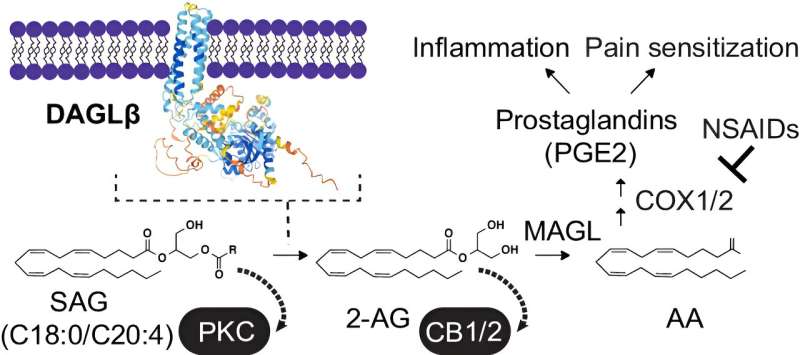
DAGLβ regulation of lipid signaling. Credit: Proceedings of the National Academy of Sciences (2023). DOI: 10.1073/pnas.2304900120
A team of researchers from Virginia Commonwealth University, the University of Texas at Austin, and the University of Virginia have made progress in developing a drug candidate to treat chronic pain more safely.
Chronic pain affects millions of people, but for many, a reliable, non-addictive medication to relieve their suffering remains out of reach. Some of the most effective medications for treating severe pain, opioids, are highly addictive and have led to public health crises related to substance use disorders and overdoses.
In their most recent study, published in Proceedings of the National Academy of Sciencesthe researchers found that the drug candidate was able to effectively trick the immune system into stopping an inflammatory response, thereby relieving pain.
Although this research is currently in the preclinical stage, the ultimate goal is to develop an effective and targeted treatment for people suffering from chronic pain.
Promising drug candidate sparks collaboration
Immune cells in the human body produce compounds called endocannabinoids that, among other things, regulate inflammation. In a healthy person, inflammation is a process that helps the body heal from infections or injuries. But the downside is that it also causes swelling and buildup of tissue that puts pressure on the nerve endings and causes persistent pain.
“When endocannabinoids in our body cause inflammation, our nerves become sensitized. They respond more quickly with less stimulation than is normally necessary. This causes things that would not normally hurt to suddenly become extremely painful, similar to how we feel when we have a severe sunburn,” said Aron Lichtman, Ph.D., professor in the department of pharmacology and toxicology at the VCU School of Medicine.
In this study, researchers analyzed an inhibitor called KT109 that blocks the activity of an endocannabinoid-producing enzyme in immune cells called DAGLβ.
Ken Hsu, Ph.D., associate professor in the Department of Chemistry at UT Austin, developed the inhibitor in 2012 as a postdoctoral researcher at the Scripps Research Institute. He has since fostered a long-term collaboration with Lichtman and Hamid Akbarali, Ph.D., also a professor in VCU’s Department of Pharmacology and Toxicology, to better understand how DAGLβ inhibition reduces inflammation and associated pain.
Akbarali’s expertise studies the impact of inflammation on the nervous system at the cellular level. His research team examined how the drug candidate interfered with pain-transmitting neurons in mouse models.
“In our lab, we study the speed and strength of pain signals that neurons send to the brain, and for this particular project, we analyzed how the drug candidate weakened these signals as they passed through the nervous system,” a- he declared.
Lichtman’s research team focused on understanding how these cellular processes impact the behavior and function of mice with chronic pain.
“Our process was truly a bottom-up discovery. This research began with understanding the inhibitor at the molecular level, while this new study aimed to better understand how the inhibitor impacts at the cellular and behavioral level,” Lichtman said.
Discover the path to pain relief
Previous work has demonstrated how KT109 controls inflammation via endocannabinoids and prostaglandins. But in this latest study, researchers were surprised to find that it also controls inflammation through an additional pathway, which explains why the inhibitor is effective in treating different types of pain.
“When you inhibit DAGLβ, your immune cells are tricked into thinking they are starving,” Hsu said. “Changes in the immune system’s energy metabolism can turn off inflammatory signaling and be effective in pain management. One example is the drug metformin,” which is commonly used to treat diabetes but has also been shown to be effective in pain treatment.
The team’s inhibitor targets the DAGLβ enzyme, which is primarily present and active in immune cells, thereby avoiding unnecessary reactions with other cells that could cause side effects.
“You’re going to affect these pathways where it matters, where inflammation occurs,” Hsu said.
Researchers do not believe this drug inhibitor acts in the brain, avoiding potential alteration of reward pathways in the brain that could lead to drug addiction.
The research team has so far only studied the effects of the inhibitor via injection, but the goal is to develop a pill that can be swallowed, much like a human would ingest a drug compound. To avoid internal toxicity, researchers will aim to refine the chemistry and reduce the number of times the drug is taken while maintaining the same analgesic effect.
These results are useful to pharmaceutical companies considering developing drugs targeting DAGLβ in people with chronic pain.
More information:
Miaomiao Chen et al, Endocannabinoid biosynthetic enzymes regulate pain response via LKB1–AMPK signaling, Proceedings of the National Academy of Sciences (2023). DOI: 10.1073/pnas.2304900120
Provided by Virginia Commonwealth University
Quote: New drug shows promise for relieving chronic pain, study finds (June 3, 2024) retrieved June 4, 2024 from https://medicalxpress.com/news/2024-06-drug-easing-chronic-pain.html
This document is subject to copyright. Except for fair use for private study or research purposes, no part may be reproduced without written permission. The content is provided for information only.